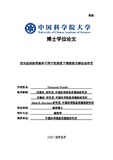Please use this identifier to cite or link to this item:
http://archive.nnl.gov.np:8080/handle/123456789/271| Title: | Leaf litter decomposition across a tropical forest disturbance gradient in Mengsong, Xishuangbanna, SW China |
| Authors: | Paudel, Ekananda |
| Keywords: | Nutrient flux leaf litter decomposition Disturbance gradient Carbon cycle Tropical forest |
| Issue Date: | 3-Jan-2018 |
| Abstract: | Deforestation and forest degradation are driving declines in biodiversity across the tropics, and understanding the consequences of these changes for ecosystem functioning is essential. Forest degradation and loss alter ecosystem functioning through changes in species composition and the micro-environment, including soil surface temperature and soil moisture. Decomposition has a substantial influence on the atmosphere through CO2 release and on ecosystems through maintaining the forest floor fertility. However, the consequences of forest degradation on ecosystem processes, such as litter fall and decomposition, remain poorly understood. To overcome this knowledge gap, highly replicated experiments were conducted to quantify the effects of forest degradation on leaf litterfall, nutrient flux, and decomposition, and to disentangle the interactions with other known determinants of litter decomposition along a tropical disturbance gradient in Mengsong, Xishuangbanna, SW China. Litterfall plays an important role in nutrient cycling and maintenance of soil fertility in terrestrial ecosystems. I studied litterfall over two years and seasonal litter nutrient input over one year across a tropical disturbance gradient from mature forest to monoculture tea plantation. The aim of this study was to determine total annual leaf-litter flux and the litter quality variation along the disturbance gradient, and also to determine the seasonal variation in the litter quality. The leaf litter was collected using litter-traps. The results demonstrated that forest degradation had a substantial effect on nutrient input to the forest floor: monoculture tea plantations had substantially lower annual nutrient input than forest habitats. However, there was no significant difference between mature forest and regenerating forests. Contrary to previous reports, the nutrient concentration of leaf litter did not vary significantly across the disturbance gradient, although there was substantial variation in plant species composition. The lack of seasonal variation in litter nutrient concentrations meant that patterns of nutrient input were driven solely by litterfall dynamics. Leaf litter decomposition was studied along the disturbance gradient through a highly replicated litter-bag experiment (3360 bags). The objectives of this experiment were to quantify the effects of litter quality, decomposer functional diversity and seasonal precipitation regime on litter decomposition In addition, a mesocosm experiment was conducted to partition the effects of litter-bed conditions and canopy openness. Using soil and litter from selected sites across the disturbance gradient, replicated litter-bed treatments were established and exposed to a gradient of simulated canopy cover in a shade-house. Across the landscape, after one year across treatments mean mass loss varied from 21% (95% CI: 18–25) to 78% (95% CI: 65–94). Litter-bags installed at the beginning of the dry season had much lower mass loss than those installed at the beginning of the wet season. As expected, litter quality and meso- and macro-faunal exclusion had substantial effects on decomposition rates. Decomposition rates declined substantially along the disturbance gradient from mature forest, through regenerating forest to open-land, although the effect size was strongly dependent on installation season. In the mesocosm experiment, mean mass loss across treatments after one year varied from 18% (95% CI: 16-21) to 78% (95% CI: 67-89). The mesocosm results broadly mirrored those from the landscape-disturbance gradient. However, mesocosm results strongly suggested forest degradation effects were driven by changes in micro-climatic conditions resulting from increased canopy openness. The home-field advantage (HFA) hypothesis, which postulates that litter decomposes faster in its native forest. Similarly, the litter with higher diversity is considered to decompose at faster rate. To test the HFA and litter diversity effects on leaf litter decomposition, an experiment was set up using mixed leaf litter in a mesocosm experiment. The mean mass loss from mixed litter after one year across treatments varied from 30% (95% CI: 28-32) to 59% (95% CI: 55-63). The result from multispecies mix litter suggested that there was no significant effect of home-field on leaf litter decomposition. In addition, it also showed that there was a wide range of litter mass loss from different types of litter, however, variability among litter types was independent of the species number in the litter mixtures. Overall, the forest degradation had a substantial impact on total leaf litterfall, nutrient return to the forest floor, and litter decomposition rates. Nutrient-transfer rates are reduced when decomposition rates are slower, which ultimately affects availability of nutrients to biotic communities in disturbed environments. To better model the impacts of anthropogenic global change on litter decomposition rates, it will be important to consider landscape scale processes, such as forest degradation. |
| Description: | A dissertation submitted to University of Chinese Academy of Sciences in partial fulfillment of the requirement for the degree of Doctor of Science, Kunming Institute of Botany, Chinese Academy of Sciences, 2015. |
| URI: | http://103.69.125.248:8080/xmlui/handle/123456789/271 |
| Appears in Collections: | 500 Natural sciences and mathematics |
Files in This Item:
| File | Description | Size | Format | |
|---|---|---|---|---|
| PhD_Thesis_Final_EN Paudel.pdf | 5.42 MB | Adobe PDF |  View/Open |
Items in DSpace are protected by copyright, with all rights reserved, unless otherwise indicated.